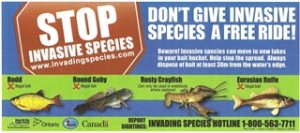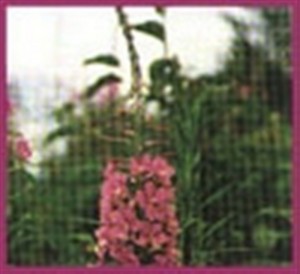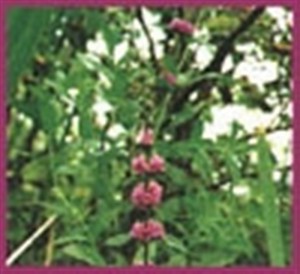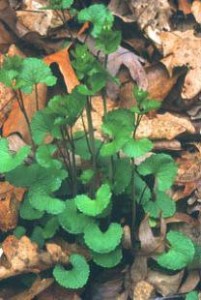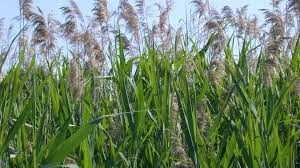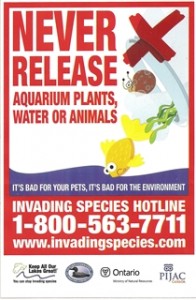INVASIVE SPECIES
- Dog-Strangling Vine
- Zebra Mussels
- purple loosestrife
- garlic mustard
- Eurasian watermilfoil
- Spiny Water flea
- Phragmites
DOG-STRANGLING VINE
Dog Strangling Vine is an extremely aggressive plant species from the milkweed family that has traditionally inhabited field borders, roadside and rail tracks. More recently it has been creeping into agricultural fields and pasture lands across Ontario, but mainly east of Toronto (see Figure 1). To minimize the impact of Dog Strangling Vine in these areas it is important to understand how this plant reproduces so that control measures are effective as possible.
General Description
Dog Strangling Vine is a perennial with a horizontal woody rootstalk or rhizome (Figure 2). The stems can range in length from 60 to 200 cm (24 – 80 inches) with a twining or scrambling configuration, hence giving it the “strangling” moniker. The leaves are ovate (oval) in shape, have smooth margins, with hairs being present on the margins and major leaf veins on the underside of the leaf (Figure 3). According to DiTommaso et al. 2005, the flowers of Dog Strangling Vine are a pink, red-brown or maroon, while “Black” Dog Strangling Vine has flowers that are dark purple to blackish. Flowers will produce pods containing seed that is similar in appearance to common milkweed.
More info can be found on the Ontario Ministry of Agriculture website
ZEBRA MUSSELS
Zebra mussels are filter feeders. When in the water, they open their shells to admit detritus.
Zebra mussels are a great nuisance to people. Since colonizing the Great Lakes, they have covered the undersides of docks, boats, and anchors. They have also spread into streams and rivers nationwide. In some areas they completely cover the substrate, sometimes covering other freshwater mussels. They can grow so densely that they block pipelines, clogging water intakes of municipal water supplies and hydroelectric companies.
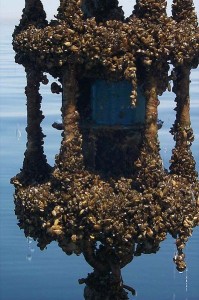 Also, as their shells are very sharp, they are known for cutting people’s feet, resulting in the need to wear water shoes.
Also, as their shells are very sharp, they are known for cutting people’s feet, resulting in the need to wear water shoes.
Zebra mussels are also believed to be the source of deadly avian botulism poisoning that has killed tens of thousands of birds in the Great Lakes since the late 1990s.
However, zebra mussels and other non-native species are credited with the increased population and size of smallmouth bass in Lake Erie and yellow perch in Lake St. Claire. They cleanse the waters of inland lakes, resulting in increased sunlight penetration and growth of native algae at greater depths. This proves beneficial for fish most of the time, helping the fish live in better conditions. This cleansing also increases water visibility and filters out pollutants. Each quagga and zebra mussel filters about a quart of water a day.
Recent research has found that zebra mussels don’t attach to copper-nickel alloys, which can be used to coat intake and discharge grates, navigational buoys, boats, motors, etc., where the pests tend to congregate.
PURPLE LOOSTRIFE
What you should know, what you can do
Purple loosestrife is a very hardy perennial which can rapidly degrade wetlands, diminishing their value for wildlife habitat. Wetlands are the most biologically diverse, productive component of our ecosystem. Hundreds of species of plants, birds, mammals, reptiles, insects, fish and amphibians rely on h ealthy wetland habitat for their survival.
However, when purple loosestrife gets a foothold, the habitat where fish and wildlife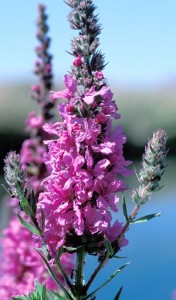 feed, seek shelter, reproduce and rear young, quickly becomes choked under a sea of purple flowers. Areas where wild rice grows and is harvested, and where fish spawn, are degraded. An estimated 190,000 hectares of wetlands, marshes, pastures and riparian meadows are affected inNorth Americaeach year, with an economic impact of millions of dollars.
feed, seek shelter, reproduce and rear young, quickly becomes choked under a sea of purple flowers. Areas where wild rice grows and is harvested, and where fish spawn, are degraded. An estimated 190,000 hectares of wetlands, marshes, pastures and riparian meadows are affected inNorth Americaeach year, with an economic impact of millions of dollars.
Purple loosestrife also invades drier sites. Concern is increasing as the plant becomes more common on agricultural land, encroaching on farmers’ crops and pasture land.
Guidelines for Purple Loosestrife Control
How to identify Purple Loosestrife
Before control activites begin, use the following diagram to be sure you are correctly identifying purple loosestrife.
Leaves: Leaves are downy, with smooth edges. They are usually arranged opposite each other in pairs which alternate down the stalk at 90 degree angles, however, they may appear in groups of three.
Perennial Rootstock: On mature plants, rootstocks are extensive and can send out up to 30 to 50 shoots, creating a dense web which chokes out other plant life.
A.) Flower: Individual flowers have five or six pink-purple petals surrounding small, yellow centers. Each flower spike is made up of many individual flowers.
B.) Seed Capsule: As flowers begin to drop off, capsules containing many tiny seeds appear in their place. Depending on where you live, plants may go to seed as early as late July.
C.) Seed: Each mature plant can produce up to 2.7 million seeds annually. As tiny as grains of sand, seeds are easily spread by water, wind, wildlife and humans. Germination can occur the following season, but seeds may lay dormant for several years before sprouting.
D.) Stalks: Stalks are square, five or six-sided, woody, as tall as 2m (6+ ft.) with several stalks on mature plants.
Guidelines for Purple Loosestrife Control: Don’t be fooled by look-alikes…
Fireweed: The conical flower spike is 10-13 cm (4-5 inches) wide at the base. Stem is round and leaves alternate.
Swamp Loosestrife: Individual flowers ring the stem above leaf pairs.
Winged Loosestrife: Leaves alternate with small stems attaching to main stem.
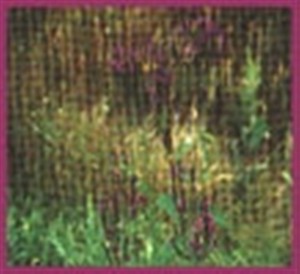 Blue Vervain: Small purple flower spikes; edges of leaves are toothed.
Blue Vervain: Small purple flower spikes; edges of leaves are toothed.
How to control Purple Loosestrife
Controlling the spread of purple loosestrife is crucial to protecting vital fish, wildlife and native plant habitat! Purple loosestrife can easily spread if improper control methods are used.
In areas too heavily infested to pull, cut or dig plants, these control techniques can still be used to control plants that may sprout as a result of seeds escaping the area. Watch drainage ditches or streams leading from heavily infested areas, as new purple loosestrife colonies are likely to become established there. Pulling, cutting, or digging plants in these more manageable infestations will limit the spread of purple loosestrife beyond the area of heavy infestation.
Digging & Hand Pulling: Pulling purple loosestrife by hand is easiest when plants are young (up to two years) or when in sand. Older plants have larger roots that can be eased out with a garden fork. Remove as much of the root system as possible, because broken roots may sprout new plants.
Cutting: Removing flowering spikes will prevent this year’s seeds from producing more plants in future years– remember each mature plant can produce over 2 million seeds per year. Also, remove last year’s dry seed heads, as they may still contain seeds. Finally, cut the stems at the ground to inhibit growth.
Biological Control: In areas of severe purple loosestrife infestation, manual and chemical control efforts are ineffective and may in fact contribute to the problem. However, the use of specially selected insects that feed on purple loosestrife is being studied to determine the effectiveness of this method for long-term control in these higher density areas.
Things to Keep in Mind
- The best time to control purple loosestrife is in late June, July and early August, when it is in flower. Plants are easily recognized, and it has not yet gone to seed. Once flower petals start to drop from the bottom of the spike, the plant begins to produce seed. Control activities can continue during this time, but require greater care so seeds are not shaken from the plant. At sites where plants have gone to seed, remove all of the flowering spikes first by bending them over a plastic bag and cutting them off into the bag. Further cutting of stems or pulling can now take place without fear of spreading the tiny seeds.
- Proper disposal of plant material is important. Put all plant pieces in plastic bags (vegetation rots quickly in plastic) and take the bags to a sanitary landfill site. Be sure the landfill site doesn’t require bags to be broken open for composting. Composting is not advised, as purple loosestrife seeds may not be destroyed and the thick, woody stem and roots take a long time to decompose. If facilities exist in your area, incineration is an effective way to dispose of plant material.
- Be aware that your clothes and equipment may transport the small seeds to new areas. Thoroughly brush off your clothes and equipment before leaving the site.
- Keep site disturbance to a minimum. Wetlands provide habitat for many native song birds, waterfowl, mammals, amphibians, and fish which depend on native wetland vegetation. Wetlands are also home to many rare and delicate plants. Take care not to trample or damage native vegetation when controlling purple loosestrife.
GARLIC MUSTARD Alliaria petiolata
DESCRIPTION:
Garlic mustard is a non-native, biennial herb that grows 5-46 inches tall. The first-year plant is in the form of a rosette with kidney-shaped leaves that remain green throughout the winter. The second year, a flowering stem is produced with triangular shaped leaves that are sharply toothed. Crushed leaves emit a garlic-like odor. The flowers bloom in a cluster at the end of the stem. Each small flower has four white petals and blooms from May to June. The fruits are long, green capsules that become brown as the seeds mature, making it easy to identify.
HABITAT:
Garlic mustard generally prefers some shade and can be found in upland and flood 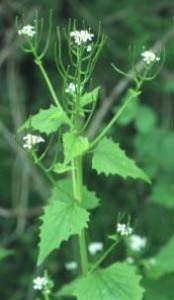 plain forests, savannas, yards, along roadsides, and occasionally in full sun. This plant invades forests first at the edge, then progresses to the interior along streams and trails.
plain forests, savannas, yards, along roadsides, and occasionally in full sun. This plant invades forests first at the edge, then progresses to the interior along streams and trails.
DISTRIBUTION:
Garlic mustard originated in Europe and was introduced to theUnited Statesfor herbal and medicinal puroses. It was first recorded in theUnited Statesin 1868 inLong Island,NewYork. By 1991, garlic mustard had invaded 28 Midwestern and northeastern states. Garlic mustard can be found throughout the state ofOhio.
Garlic mustard aggressively out-competes native species in the understory of forests and woodlands. This plant begins growth in early spring and ends growth later in the season than most native species. As a result, garlic mustard shades out native wildflowers and out-competes native seedlings. Garlic mustard grows in dense clusters and can displace most herbaceous native plants within 10 years. Large quantities of seed are produced and can remain viable in the soil for up to 7 years. The seeds are dispersed by wind, water and transported by animals and humans.
CONTROL:
Mechanical: Mechanical controls of garlic mustard include hand-pulling and cutting, and are most effective on smaller infestations. Hand-pulling of plants can be very effective, although labor intensive. Care must be taken to insure that the entire plant is removed and that all plant materials are bagged and moved off-site. A plant can continue to mature and produce seeds even if it has been pulled up. Hand-pulling and removal must continue until the seed bank is exhausted (at least 7 years). Cutting populations of garlic mustard is effective for medium to large concentrations of plants. Stems may be cut by mowing, brush-cutting, or by hand when the plants are in flower. This can result in total mortality of the plants, however it does not affect the seed bank. Cutting must continue every year until the seed bank is exhausted. Prescribed fire can be an effective control agent in 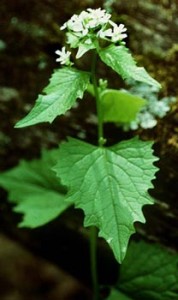 controlling garlic mustard given the proper location and fire intensity. Repeated, effective burns over several years are necessary.
controlling garlic mustard given the proper location and fire intensity. Repeated, effective burns over several years are necessary.
Chemical: Foliar application of herbicide can be used to control populations of garlic mustard where mechanical methods may not be effective, such as large infestations. Roundup® or Glypro® are effective herbicides to use, however they are not selective so non-target species in the vicinity of the application may be affected. Herbicide should be applied to the first year rosettes during the late fall and early spring when non-target species are dormant.
EURASIAN WATERMILFOIL
is another invasive species. It has been present in the Rideau area since about 1970. The eurasian variety of watermilfoil is a tough-stemmed, stringy weed, with 12 to 21 small feathery leaflet pairs every 3 cm or so. When the growing plant nears the surface, shoots branch profusely, forming a de nse canopy. These thick canopies (mats) can choke out a waterway, clog boat propellers and generally make the use of a lake difficult. One of the reasons it can spread so quickly is that it can reproduce through stem fragmentation and underground runners.
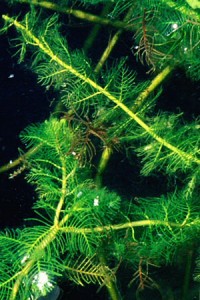 Eurasian watermilfoil adversely impacts aquatic ecosystems by forming dense canopies that often shade out native vegetation. Monospecific stands of Eurasian watermilfoil provide poor habitat for waterfowl, fish, and other wildlife. Significant rates of plant sloughing and leaf turnover, as well as the decomposition of high biomass at the end of the growing season, increase the internal loading of phosphorus and nitrogen to the water column. Dense Eurasian watermilfoil mats alter water quality by raising pH, decreasing oxygen under the mats, and increasing temperature. In easternWashington, Eurasian watermilfoil impacts power generation and irrigation by clogging dam trash racks and intake pipes. Stagnant water created by Eurasian watermilfoil mats provides good breeding grounds for mosquitoes. Eurasian watermilfoil interferes with recreational ac tivities such as swimming, boating, fishing and water skiing. InWashington, private and government sources spend about $1,000,000 per year on Eurasian watermilfoil control. Other states and provinces (Minnesota,Wisconsin,Vermont,New York, andBritish Columbia) spend similar amounts per year to control Eurasian watermilfoil infestations.
Eurasian watermilfoil adversely impacts aquatic ecosystems by forming dense canopies that often shade out native vegetation. Monospecific stands of Eurasian watermilfoil provide poor habitat for waterfowl, fish, and other wildlife. Significant rates of plant sloughing and leaf turnover, as well as the decomposition of high biomass at the end of the growing season, increase the internal loading of phosphorus and nitrogen to the water column. Dense Eurasian watermilfoil mats alter water quality by raising pH, decreasing oxygen under the mats, and increasing temperature. In easternWashington, Eurasian watermilfoil impacts power generation and irrigation by clogging dam trash racks and intake pipes. Stagnant water created by Eurasian watermilfoil mats provides good breeding grounds for mosquitoes. Eurasian watermilfoil interferes with recreational ac tivities such as swimming, boating, fishing and water skiing. InWashington, private and government sources spend about $1,000,000 per year on Eurasian watermilfoil control. Other states and provinces (Minnesota,Wisconsin,Vermont,New York, andBritish Columbia) spend similar amounts per year to control Eurasian watermilfoil infestations.
Control of eurasian watermilfoil is difficult. Since its main form of reproduction is through stem fragmentation, chopping it up only leads to further spreading. Some herbicides have proven effective depending on the environment the milfoil is located in. A new herbicide, triclopyr, shows great promise in controlling eurasian milfoil. Harvesting (cutting and removing the plant material) is effective in controlling eurasian watermilfoil but not eradicating it. In B.C., a device called a “rotovator” which removed the milfoil’s root system will generally keep the milfoil at bay for two or three years. Biological control methods have so far been unsuccessful, but research into the use of a freshwater weevil now appears to be quite promising.
Response to Cultural Methods
Localized control (in swimming areas and around docks) can be achieved by covering the sediment with a opaque fabric which blocks light from the plants (bottom barriers or screens). Managers of reservoirs and some lake systems may have the ability to lower the water level as a method of managing aquatic plants. The Tennessee Valley Authority (TVA) uses both winter and summer water level drawdowns as effective way of reducing Eurasian watermilfoil biomass. They find that a drawdown of about 2 meters is effective in reducing excessive populations. Short-term dewatering for 2-3 days during period of freezing temperatures has been effective, but multiple exposures may improve control. A 1-week drawdown of a large TVA impoundment in July 1983 desiccated about 810 hectares of Eurasian watermilfoil. A narrow, relatively weed-free band occurred after refilling and control effects extended into the following two growing seasons. InWashington, the Bureau of Reclamation lowered the water level ofBanksLakein 1994 in an effort to manage Eurasian watermilfoil populations. The success of a drawdown on Eurasian watermilfoil is dependent on several factors such as degree of desiccation (drawdowns in rainy westernWashingtonare often ineffective), the composition of substrate (sand vs. clay), air temperature (the exposed sediments need to freeze down to 8-12 inches), and presence of snow.
Response to Mechanical Methods
Because this plant spreads readily through fragmentation, mechanical controls such as cutting, harvesting, and rotovation (underwater rototilling) should be used only when the extent of the infestation is such that all available niches have been filled. Using mechanical controls while the plant is still invading, will tend to enhance its rate of spread.
Rotovation: The British Columbia Ministry of Environment developed a barge mounted rototilling machine called a rotovator to remove Eurasian watermilfoil roots. Underwater tiller blades churn up to 8 inches into the sediment and dislodge buoyant Eurasian watermilfoil roots. Floating roots may then be collected from the water. Control with rotovation, generally extends 2 or more growing seasons.
Harvesting: Harvesting can be compared to underwater lawn mowing. Plants are cut generally 5 feet below the water’s surface, collected by conveyer, and stored until disposal on land. Harvesting removes surfacing mats and creates open areas of water. However because of its rapid growth rate Eurasian watermilfoil generally needs to be harvested twice during the growing season.
Cutting: Cutting is similar to harvesting except cut plants are not picked up from the water by the cutting machine.Washingtonrequires that cut plants be removed from the water.
Biocontrol Potentials
Insects: The United States Department of Agriculture in conjunction with the Army Corps of Engineers have carried out searches for Eurasian watermilfoil biological control agents in Pakistan, Bangladesh, China, Korea, and Yugoslavia. Several insects have been evaluated, including a number of pyralid moths and several stem-boring weevils. However, many of these insects were found to be non-specific to Eurasian watermilfoil or to offer little potential as effective biological control agents. InBritish Columbia, several insects were associated with Eurasian watermilfoil and a midge was investigated as a potential control agent. However, the midge proved to be extremely difficult to rear in the laboratory.
The North American weevil, Euhyrchiopsis lecontei (Dietz) has been found associated with declining populations of Eurasian watermilfoil in northeastern North America. Euhrychiopsis lecontei has been found in Washington state feeding on both Eurasian watermilfoil and northern milfoil (Myriophyllum sibericum) plants. Studies have shown that this native weevil appears to be a milfoil specialist and will not feed on other macrophyte species. It can be easily raised in the laboratory and laboratory-reared weevils could be used to augment natural populations, as is being tried inVermont and in other states. Weevil augmentation studies for Eurasian watermilfoil management are being proposed forWashingtonState. A researcher at theUniversity ofWashington is conducting an evaluation of whether the milfoil weevil will be a suitable control for Eurasian watermilfoil inWashington.
Grass Carp: Although triploid grass carp will eat Eurasian watermilfoil, it is not a highly palatable or preferred species. To achieve control of Eurasian watermilfoil generally means the total removal of more palatable native aquatic species before the grass carp will consume Eurasian watermilfoil. In situations where Eurasian watermilfoil is the only aquatic plant species in the lake, this may be acceptable. However, generally grass carp are not recommended for Eurasian watermilfoil control.
Plant Pathogens: Interest in pathogens of Eurasian watermilfoil was stimulated by extensive mortality of Eurasian watermilfoil in LakeVeniceand the Northeast River, Maryland in the late 1960s. At that time, the declines (called Northeast Disease) were suspected to be caused by a pathogen, although no pathogens were ever isolated. However Northeast Disease stimulated research into the use of plant pathogens for biological control. The plant pathogenic fungus Mycoleptodiscus terrestris has been shown to significantly reduce Eurasian watermilfoil biomass in laboratory studies. A commercial biotechnology firm spent several years developing this fungus as a biological tool to control Eurasian watermilfoil, but was unable to achieve control of the plant in field settings. The US Army Corps of Engineers is continuing research on plant pathogens.
Phragmites
Phragmites australis subsp. australis
Invasivesive Phragmites (European Common Reed) is an invasive plant causing damage to Ontario’s biodiversity, wetlands and beaches. Invasive Phragmites is a perennial grass that has been damaging ecosystems in Ontario for decades. It is not clear how it was transported to North America from its native home in Eurasia.
Invasive Phragmites is an aggressive plant that spreads quickly and out-competes native species for water and nutrients. It releases toxins from its roots into the soil to hinder the growth of and kill surrounding plants. While it prefers areas of standing water, its roots can grow to extreme lengths, allowing it to survive in relatively dry areas.
Impacts of Invasive Phragmites
- Crowds out native vegetation, thus resulting in decreased plant biodiversity.
- Generally provides poor habitat and food supplies for wildlife, including several Species at Risk.
- Grows very quickly thereby causing lower water levels as water is transpired faster than it would be with native vegetation.
- Increases fire hazards as stands are composed of a high percentage of dead stalks.
- Can affect agriculture, cause road safety hazard and impact recreational activities such as swimming, boating and angling.
How to Identify Invasive Phragmites
One factor making the identification of invasive Phragmites difficult is the existence of a closely related native subspecies. Generally, native Phragmites does not grow as tall as the invasive plant and does not out-compete other native species. A number of characteristics of the plant can be useful in distinguishing between the native variety and invasive Phragmites. The following information can help in identifying invasive Phragmites.
Invasive Phragmites:
- Grows in stands that can be extremely dense with as many as 200 stems per square metre.
- Can grow so densely that it crowds out other species.
- Can reach heights of up to 5 metres (15 feet).
- Has stems that are tan or beige in colour with blue-green leaves and large, dense seedheads.
Native Phragmites:
- Grows in stands that are usually not as dense as the invasive plant;
- Well-established stands are frequently mixed with other plants; and
- Usually has more reddish-brown stems, yellow-green leaves and smaller, sparser seedheads.
What You Can Do
- Learn how to identify invasive Phragmites and how to avoid accidentally spreading it through its root fragments and seeds. This is especially important if you are planning to do work in an area which contains invasive Phragmites.
- Learn how to effectively manage Phragmites on your property. The guide to Best Management Practices for Phragmites describes the most effective and environmentally safe control practices for this species.
- Never buy or plant invasive Phragmites. It is against the law to buy, sell, trade or purposely grow invasive Phragmites.
- Stay on designated trails and keep pets on a leash. Leaving trails or entering areas containing invasive Phragmites can encourage the spread of this plant.
- When leaving an area containing invasive Phragmites, inspect, clean and remove mud, seeds and plant parts from clothing, pets (and horses), vehicles (including bicycles and ATVs), and equipment such as mowers and tools.
- Do not compost invasive Phragmites in your backyard composter. Both seeds and rhizomes (horizontal plant stems growing underground) can survive and grow in compost, unless high enough temperatures are reached to kill the reproducing structures. Contact your local municipality to determine if plant material can be brought to their composting facility. Ontario composting facilities monitor the compost process and meet provincially regulated temperature requirements.
Spiny Water Flea
( Bythotrephes longimanus )
This is not yet in LBL but could soon be….
![]() The spiny water flea is a predacious zooplankton species and a member of the group of organisms known as crustaceans. Shrimp, crayfish, and lobster also belong to this group and the spiny water flea is a relative of another Great Lakes invader – the fishhook water flea. Introduced to North America from the ballast waters of Eurasian ships in 1982, the spiny water flea has spread throughout all the Great Lakes and more than 60 inland lakes in Ontario.
The spiny water flea is a predacious zooplankton species and a member of the group of organisms known as crustaceans. Shrimp, crayfish, and lobster also belong to this group and the spiny water flea is a relative of another Great Lakes invader – the fishhook water flea. Introduced to North America from the ballast waters of Eurasian ships in 1982, the spiny water flea has spread throughout all the Great Lakes and more than 60 inland lakes in Ontario.
Characteristics
Spiny water flea prey on small organisms called zooplankton and can consume up to 20 per day. The spiny water flea is about 1 to 1.5 cm ( .4 – .6 in ) long. As its common name suggests, it has a long tail spine with barb-like projections. The head has a large black eye and a pair of swimming antennae. Also present are a pair of mandibles, or jaws used to pierce and shred its prey. The animals possess four pairs of legs; the first, longer pair are used for catching prey, whereas the other pairs of limbs are designed for grasping prey while they are being consumed.
Spiny water flea is parthenogenetic which means that it can reproduce asexually and sexually. When conditions are ideal, female spiny water fleas reproduce asexually to produce identical female offspring. Females can produce from one to ten eggs asexually that are able to develop into new females every two weeks. In situations of environmental stress (i.e. low water temperatures, not enough food, etc.), females produce males and mate to produce “resting eggs”, which can remain dormant over long periods of time–over winter and even out of water for a period of time–then hatch when environmental conditions improve. Reproductive females carry their offspring on their backs in a balloon-like brood pouch, which can be filled with either developing embryos or resting eggs. Life span varies from several days to a few weeks.
Spiny water fleas are more common in deep, cool lakes, however, they do live in warmer lakes where surface water temperatures can exceed 25° C. Although the spiny water flea can swim up and down in the water column to avoid predators, it relies on current to carry it any great distance.
water temperatures can exceed 25° C. Although the spiny water flea can swim up and down in the water column to avoid predators, it relies on current to carry it any great distance.
It eats the same food as small and young fish, and thanks to its long tail the spiny water flea cannot be eaten by small and young fish. “They spit it out because they can’t swallow it,” said Geoff Loosemore, an invasive species monitor with the Hit Squad, created by a Ontario Federation of Anglers and Hunters and Ministry of Natural Resources partnership to quell invasive species. “This is a very aggressive carnivore.”
Distribution
It is believed that the spiny water flea first arrived in North America in the ballast water of Eurasian ships. The first recorded occurrence of the spiny water flea in North America was in Lake Ontario in 1982, and by 1987 it was present in all of the Great Lakes. This crustacean’s known range in Ontario now includes over 120 inland lakes and waterways. If the proper precautions are not taken, spiny water fleas can be further spread unknowingly by boaters and anglers.
It has only been invasive in Ontario for 15 years. Last year, seven new inland lakes were found to have spiny water fleas. It is only a matter of time before the bug makes its presence felt in other lakes.
Impact
The spiny water flea feeds on small animal life called zooplankton. When populations of this invader are high, zooplankton consumption can be significant. Compared to native zooplankton species, it eats up to three times as much food. Unfortunately, this prey is also the preferred food of native predatory zooplankton and native species of juvenile fish, resulting in direct competition. Research on the impact of the spiny water flea has shown changes in both the abundance and the diversity of zooplankton species. However, it is still too early to determine if spiny water flea will alter our aquatic ecosystems to the detriment of fish populations.
Fish will feed on spiny water fleas. However, for fish smaller than 10 cm ( 3.9 in ) long, the tail spine of the spiny water flea gets caught in the throat and the organism is literally coughed out. To date, scientists have not observed a decline in the number of small fish due to the fish’s inability to feed on spiny water flea and competition with it for food. However, over time, the possibility of an impact on fish populations is possible.
Spiny water fleas can become entangled in fishing lines and downrigger cables. When the cable is pulled from the water, the spiny water fleas attached to the cable look like straight pins. You may see them raise and lower their tails as they cling to the line.
Prevention
Presently, the best defence against the spiny water flea is to prevent its transfer to new waterbodies. Spiny water flea eggs and adults can get into bilge water, bait buckets, livewells and coat fishing lines when boating or fishing in infested waters. Please take the following precautions to prevent the spread of spiny water flea and other invading species to new waterbodies:
Inspect your boat, trailer, boating equipment, fishing tackle and nets and remove any visible plants or animals before leaving any waterbody.
Drain water from motor, live well, bilge and transom wells while on land before leaving the waterbody.
Empty your bait bucket on land before leaving the waterbody. Never release live bait into a waterbody, or release animals from one waterbody into another.
Wash/Dry your fishing tackle, nets, boat and equipment to kill harmful species that were not seen at the boat launch. Some species can survive for several days out of water, so it is important to:
- rinse your boat and equipment with hot tap water (> 50° C); or
- spray your boat and equipment with high pressure water (250 psi); or
- dry your boat and equipment for at least five days, before transporting to another waterbody;

